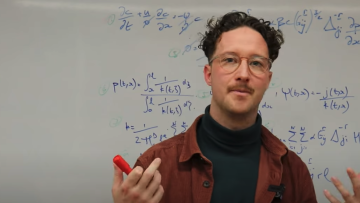13:00
Disordered quantum critical fixed points from holography
Abstract
In this talk I will describe the systematic construction of strongly interacting RG fixed points with a finite disorder strength. Such random-field disorder is quite common in condensed matter experiment, necessitating an understanding of the effects of this disorder on the properties of such fixed points. In the past, such disordered fixed points were accessed using e.g. epsilon expansions in perturbative quantum field theory, using the replica method to treat disorder. I will show that holography gives an alternative picture for RG flows towards disordered fixed points. In holography, spatially inhomogeneous disorder corresponds to inhomogeneous boundary conditions for an asymptotically-AdS spacetime, and the RG flow of the disorder strength is captured by the solution to the Einstein-matter equations. Using this construction, we have found analytically-controlled RG fixed points with a finite disorder strength. Our construction accounts for, and explains, subtle non-perturbative geometric effects that had previously been missed. Our predictions are consistent with conformal perturbation theory when studying disordered holographic CFTs, but the method generalizes and gives new models of disordered metallic quantum criticality.
16:00
New Lower Bounds For Cap Sets
Abstract
A cap set is a subset of $\mathbb{F}_3^n$ with no solutions to $x + y + z = 0$ other than when $x = y = z$, or equivalently no non-trivial $3$-term arithmetic progressions. The cap set problem asks how large a cap set can be, and is an important problem in additive combinatorics and combinatorial number theory. In this talk, I will introduce the problem, give some background and motivation, and describe how I was able to provide the first progress in 20 years on the lower bound for the size of a maximal cap set. Building on a construction of Edel, we use improved computational methods and new theoretical ideas to show that, for large enough $n$, there is always a cap set in $\mathbb{F}_3^n$ of size at least $2.218^n$. I will then also discuss recent developments, including an extension of this result by Google DeepMind.
A (quasi)-polynomial Bogolyubov theorem for finite simple groups
Abstract
We show that there exists $C>1$, such that if $A$ is a subset of a non-alternating finite simple group $G$ of density $|A|/|G|= \alpha$, then $AA^{-1}AA^{-1}$ contains a subgroup of density at least $\alpha^{C}$. We will also give a corresponding (slightly weaker) statement for alternating groups.
To prove our results we introduce new hypercontractive inequalities for simple groups. These allow us to show that the (non-abelian) Fourier spectrum of indicators of 'global' sets are concentrated on the high-dimensional irreducible representations. Here globalness is a pseudorandomness notion reminiscent of the notion of spreadness.
The talk is based on joint works with David Ellis, Shai Evra, Guy Kindler, Nathan Lindzey, and Peter Keevash, and Dor Minzer. No prior knowledge of representation theory will be assumed.
Geometrisation of the Langlands correspondence
Abstract
I'll give an introduction to a recent theme in the Langlands program over number fields and mixed characteristic local fields (with a much older history over function fields). This is enhancing the traditional 'set-theoretic' Langlands correspondence into something with a more geometric flavour. For example, relating (categories of) representations of p-adic groups to sheaves on moduli spaces of Galois representations. No number theory or 'Langlands' background will be assumed!


